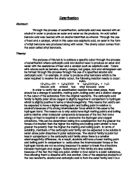RESULTS
ANALYSIS
From the above recordings, the percentage yield of this experiment can be found. This is done by dividing the yield of crystals obtained by the initial weight of the impure benzoic acid and then multiplying by 100.
0.6695g = 0.44636309
1.4999g . .
0.44636309x100 = 44.636309%
Percentage yield = 44.63%
The thiocyanate salt was the contaminant in this experiment. This is seen on the IR spectra as a single, sharp, medium band at a frequency between 1800 cm-1 and 2500 cm-1 showing it’s a C=O bond and a carboxylic acid. In the IR spectra of impure benzoic acid this peak is at 2065.41 cm-1. In the IR spectra of the sample obtained during the experiment this peak has completely disappeared suggesting that the sample is purer then the impure sample. There was a peak in the IR spectra of the impure benzoic acid, which was not present in the pure IR spectra. This was a single peak of wavelength 3444.75 cm-1. This could be the O-H bond of an impurity like an alcohol group. In the IR spectra of the sample obtained in the experiment, the peak is not present. This also contributes to the idea of a purer sample being obtained.
A colorimetric test for the anionic impurity of [SCN]- is to add iron(III). Once this is added, if a thiocyanate ion is present then the solution will turn to a dark red colour [1] .
DISCUSSION
Goggles, lab coats and gloves must be worn at all times during this experiment. This is important as benzoic acid is an irritant. It is harmful if swallowed or inhaled. If in contact with skin it can cause redness over a long period of time.
The use of compressed KBr discs is an easier and more reliable method of infa-red spectroscopy than the ‘mull’ method of infra-red spectroscopy. This is due to the fact that there is no problem with absorption peaks due to the mulling liquid and it also provides for a much better technique since it is possible to weigh the amounts of sample and KBr present in the disc [2] .
When the solution was removed from the ice bath the white crystals were visible. When the Buchner funnel was used the filter paper was placed in the tray and had to be wet with water to ensure the seal was strong. Once the solution was passed through the funnel, there was still some residue left in the beaker. It reduce any errors in the practical it was necessary to wash the residue and get as much as possible through the funnel to gain an accurate yield. The glass rod was rinsed for the same reasons.
The percentage yield would be 44.63% if the entire product obtained was pure benzoic acid however due to the errors which have been discussed the investigation was less accurate and the percentage yield was not what it should have been.
The yield also decreased due to the transferring of the crystals from the filter paper to the watch glass. Not all of the crystals were transferred; some crystals would still have remained on the filter paper and on the spatula used to transfer the crystals thus decreasing the efficiency of the experiment. The mass balance played a part in the errors. Although the mass balance is correct to four decimal points, more decimal places would increase the accuracy of this experiment. Also the reading given was not always accurate as when pressure was placed on the workbench the reading would fluctuate.
The melting point of the re-crystallised solid sample was 119°C which is lower than the expected pure benzoic acid which is 122°C. This shows that the sample was not completely pure and that there were some signs of impurities present which lowers the melting temperature and broadens the range [3] . This contradicts the IR spectra, as the impurity seemed to have disappeared completely due to the peaks in question not being there therefore the percentage yield in reality is lower than 44.63% dependant on how pure the sample is.
CONCLUSION
The purity of a sample is not always 100% pure due to some of the impurities remaining, mostly due to human error which have been discussed in this report shown by the melting point of the recrystallised sample being lower than that of the expected pure benzoic acid.
The Infrared spectroscopy method for this experiment is also quite difficult because there are many different bonds for each group so it is confusing to find what the contaminant really is.
Finally, this experiment has a low percentage yield at 47.17% due to all the errors at transferring at the different stages of the experiment.
REFRENCE
[1] – Goswami, D.C and Kalita, H. (1988), Rapid Determination of Iron in Water by Modified Thiocyanate Method (DefSci J, Vol38, NO. 2, p177-182)
[2] – Seamus P.J.Higson, Analytical Chemistry (2004) Pages 349-350, Oxford University Press
[3] – Royal Society of Chemistry, URL: Accessed on 17/11/12









